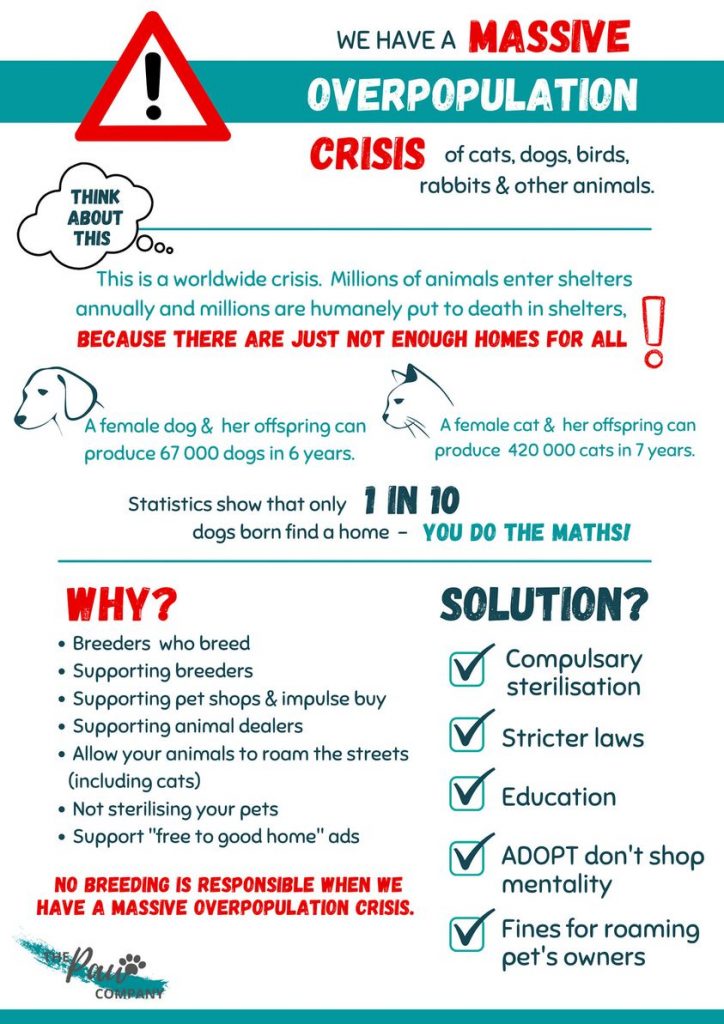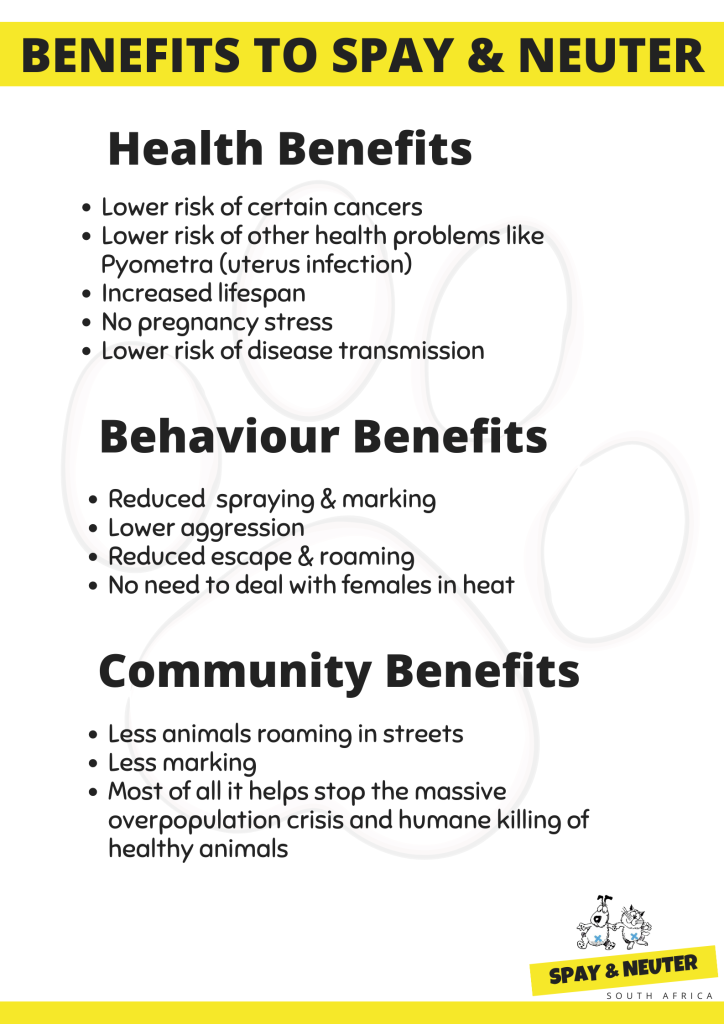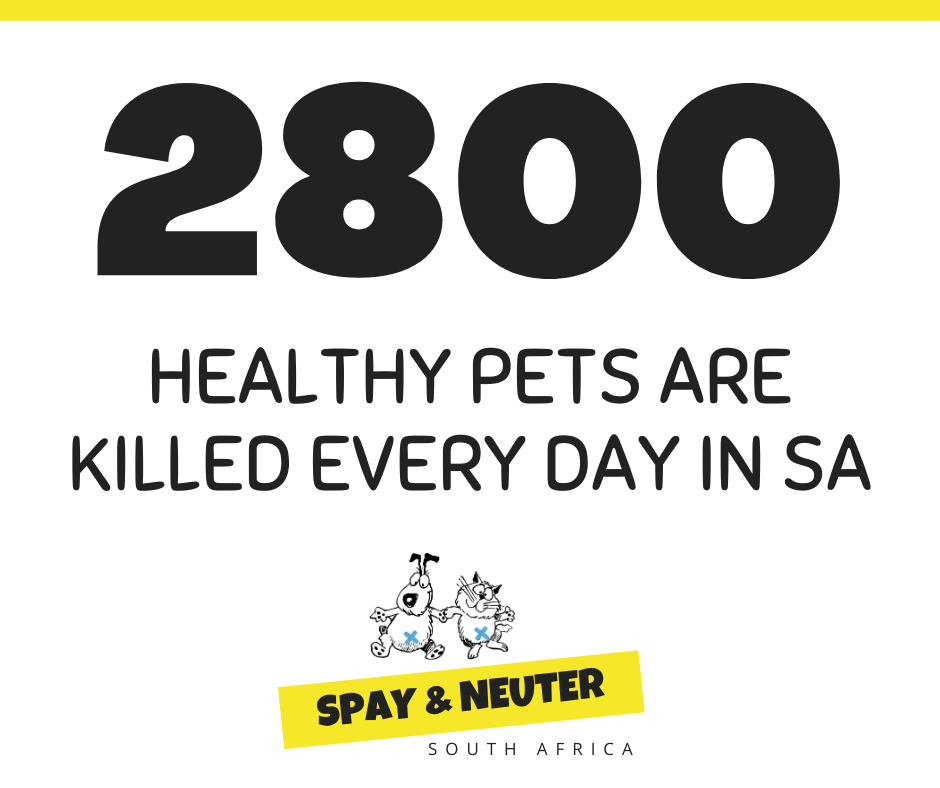
SPAYING AND NEUTERING HAS MANY BENEFITS, INCLUDING HEALTH, BEHAVIOUR & COMMUNITY BENEFITS.
When it comes to the animals we choose to share our lives with, it is our responsibility to keep them safe, and healthy and to meet all their needs. We also need to make sure that they do not become a nuisance in our communities. There are two major reasons why we promote spay & neuter:
1. We have a massive overpopulation crisis in SA and worldwide. It is so bad that around 2800 healthy animals are HUMANELY KILLED (Euthanized) DAILY IN SA!
2. It can be beneficial for their health & behaviour!
We will get back to those in a moment, but first, let’s look at the definitions and methods used for spaying and neutering.
At maturity (6-9 months of age) male dogs and cats are capable of breeding. Female dogs experience a “heat” cycle approximately every six months, depending upon the breed. A female dog’s heat cycle can last as long as 21 days during which your dog will leave bloodstains in the house and may become anxious, short-tempered and actively seek a mate. Female cats can come into heat every 2 weeks during breeding season until they become pregnant and they can fall pregnant as young as 4 months of age.
WHAT DOES SPAY & NEUTER MEAN?
Recognizing the difference between sterilization and desexing (traditional spay and neuter) is important. Whereas the former procedure eliminates a dog’s ability to procreate, desexing sterilizes but also eliminates the dog’s ability to produce sex hormones for the remainder of their life.
Vetcare.com defines it as follows: The word “spay” refers to the sterilization of female pets. During the ovariohysterectomy, or the typical “spay”, the ovaries, fallopian tubes and uterus are removed from a female dog or cat. The term “neuter” refers to the castration of male pets. During orchiectomy or the typical “neuter”, the testes are removed from a male dog or cat.
Both the spay and neuter procedures make them unable to reproduce and reduce or eliminate breeding-related behaviours. In females, it eliminates her heat cycle.
METHODS USED
According to Dr. Karen Becker, traditional spaying and neutering are basically the only techniques vets are currently taught and we need to change that. Each of the following comes with its own risk-benefit analysis and might not mean zero risk of pregnancy. Keeping the testes or uterus increases those risks for infections and cancers for example.
MALES
- Neuter where testes are removed.
- Vasectomy where testes are kept intact.
FEMALES
- Tubal ligation – similar to “tube tie”
- Ovary sparing spay – removal of uterus and cervix only.
- Overiectomy – referred to as laparoscopic spay. Removal of ovaries, but not the uterus.
- Ovariohysterectomy – removal of ovaries and uterus. (Traditional full spay)
Choosing to keep an animal intact (medical reason or not) requires a highly……I mean highly responsible pet guardian (owner). Keep in mind a guy called Murphy and the massive overpopulation crisis! Let’s get back to the reasons to spay and neuter.
- THE PET OVERPOPULATION CRISIS.
Our biggest struggle in animal welfare is the MASSIVE OVERPOPULATION CRISIS, especially cats and dogs, but also parrots, rabbits and other animals. There are just not enough homes for us to adopt our way out of this mess. Breeders breed them faster than we can save them. If there are fewer animals then fewer of them can fall into the wrong hands and be neglected or abused.
You need to understand the magnitude of this overpopulation crisis and then, hopefully, you will understand why many of us advocate so hard for it.
- According to Rescue Rehab SA, approximately 1 million dogs and cats are euthanized in South Africa every year, that is 2740 a day and likely an underestimation!
- One female cat and her offspring can exponentially produce 370 000 cats in just seven years and one female dog and her offspring can exponentially produce 67 000 dogs in six years. We are not even talking about the males who can impregnate multiple females in the same time.
- Another estimation is that only about 1 out of every 10 dogs born find a home.
- According to the Humane Society of the USA, a cat or dog is euthanized at shelters every 10s.
- A report by Mars Petcare showed 224 million animals are homeless in the USA, UK, SA, Mexico, Greece, Russia, China, India & Germany and about 30% of animals in SA are homeless.
- At least one in four pets brought to shelters are purebred and this number is climbing.
WHY DO WE HAVE THIS MASSIVE OVERPOPULATION CRISIS?
We are in this mess because people do not sterilize their pets, they support breeders and pet shops or give or sell these sentient beings to anyone. Breeders selfishly exploit animals for financial gain and fuel the massive overpopulation crisis. Many people do not keep their animals, including cats, safe in their yards so they roam the streets where they can get lost and end up in shelters or will likely fall pregnant or get another pregnant.

2. IT IS GOOD FOR THEIR HEALTH & BEHAVIOUR
When you spay and neuter your pets it can lead to longer and happier lives. There are many health benefits of spaying and neutering which include a lower risk for certain diseases like cancers and pyometra. It improves behaviour, especially when dealing with females in heat and males marking or spraying and wandering out of the yard in search of these females which they can smell from far away.
BENEFITS OF STERILIZATION
- Your pet will live a longer, healthier life.
- Cancer and other malignant conditions are the number one cause of death in adult dogs. In a cancer study with 3452 dogs, the researchers found that males tend to be diagnosed at a younger age than females BUT NEUTERED MALE DOG dogs tended to be diagnosed when they were significantly older than intact dogs. Spaying and neutering help prevent certain types of cancers like mammary tumours, testicular cancer, prostate disease and sexually transmitted diseases.
- For females, it decreases the risk of developing Pyometra (pus in the womb) which is very dangerous.
- Your spayed female won’t go into heat and cause behaviour changes for her and the males looking for a mate.
- An intact male will do just about anything to find a mate! That includes digging his way under the fence to escape from the yard and once he’s free to roam, he risks injury in traffic and fights with other males or being stolen.
- Intact male dogs and cats may mark their territory by spraying strong-smelling urine all over the house.
- Your pet will not cause an upheaval in the neighbourhood.
- Neutered male cats and dogs fight less, resulting in fewer battle scars, and the spread of contagious diseases and abscesses.
- Spaying and neutering your pet is good for the community because stray animals pose a problem for a few reasons including, they can get into fights, cause car accidents, become a nuisance and frighten people and other animals.
- There are risks associated with pregnancy and it takes a toll on the mom’s body. Many are not always able to give birth naturally, and this incurs high veterinary costs as caesareans may need to be performed and/or other complications may arise. Many animals die in labour. It certainly eliminates the stress associated with pregnancy.
- Veterinary care related to unsterilised animal health issues (cancers, fights, pyometra) can be expensive. Providing proper care for the litter is also expensive.
- Spaying and neutering help fight the pet overpopulation. Every year, millions of cats, dogs and other animals of all ages and breeds are euthanized or suffer as strays, because there are just not enough homes. Sterilization takes a few minutes, but the suffering of an abandoned animal takes a lifetime.
- The costs in terms of euthanase, burial/incineration and even human stress are enormous.

THE BIGGEST CRITICISM FOR SPAY & NEUTER
A topic that creates a lot of controversy in some circles is whether to do full spay and neuter or keep some sex organs intact, to spay or neuter early or later, or whether to spay or neuter at all. There are always two sides to a coin and it is important to look at both sides.
Some research shows that with desexing spays and neuters – surgical procedures that remove the gonads and associated sex hormones – it can have a long-term negative impact on the animal’s health. The research, for the most part, suggests this more in large dog breeds, in only a few studies. The advice then is to have them spayed or neutered after they turn one year old, but then again, they need a highly responsible owner. You must also remember that the relationship between sex hormones, health and wellness is more complex and can be influenced by many aspects like sex, breed, age, environment and more.
Some suggest they develop other cancers and ACL (knee ligament) injuries are another favourite to throw in. Many things can cause cancer including their diet, genetics and other pollutants (lawn chemicals, cleaning products etc). I work with human ACL rehab and there are a few factors to those injuries. FYI….people who are not spayed/neutered get them too.
Spay and neuter SA have looked at much of the evidence presented and for me, currently, the benefits still outweigh the potential health risks. Keep in mind there may be exceptions and we support doing what is best for the individual pet too. When it comes to the ability to spay or neuter early, it depends on the skills of the vet and the individual health of the pet.
So, to spay and neuter or not and when? Discuss it with your trusted veterinarian. My advice is…….volunteer at a shelter to help you decide on it in general and then also look at your individual pet, their breed and needs.
I have not yet seen these negative effects myself and I think there is more research needed on this as single case studies of low quality, are not enough to convince me. With this massive overpopulation crisis worldwide, the benefits far outweigh the risks.
What are alternatives then?
When a pet is left intact, it requires a highly responsible pet guardian who is fully committed to and capable of preventing mating and litters. Another option is sterilizing so the testes or ovaries can continue to produce hormones. This can be accomplished and I would possibly consider support for the vasectomy and ovary-sparing spay if enough high-quality studies prove negative long-term health effects with full spay or neuters. Keep in mind that the risks for cancers or disease in those organs will remain. If long-term health issues do occur after spaying or neutering, it seems that hormone restoration therapy may be beneficial to symptomatic spayed and neutered dogs.
Also see, how to choose a veterinarian
WHY ARE RESCUES SO STRICT WHEN IT COMES TO STERILIZATION?
It is counterintuitive to our mission as rescuers to allow puppies, kittens, birds or bunnies to be homed where there are any unsterilized animals. We would not have this massive overpopulation crisis if people sterilized their pets. Be extremely weary of any organization that is not asking why you have unsterilized pets, who sells animals (not doing home checks and contracts), or who breeds themselves, and we have such organizations locally! We believe that responsible pet guardians sterilize their pets, so even if you adopt a dog, we want your bunny to be sterilized.

Also read why “free to good home” is a problem.
BE PART OF THE SOLUTION AND JOIN THE SPAY & NEUTER REVOLUTION
Changing the fate of animals and the massive overpopulation crisis resolves around three principles namely sterilization, education, and stricter and enforced laws for those who don’t respond to being asked nicely. No breeding can be “responsible” when we have a massive overpopulation crisis and when you support breeders, pet shops or free animals, you are part of the problem.
- Spay & neuter your pets.
- Share, educate & advocate for it.
- Donate to spay & neuter campaigns.
- Support petitions and legislation on the topic.
- Don’t support animal dealers, breeders, or pet shops that fuel the overpopulation crisis.
- Keep your animals safe in your yard.
- Adopt from reputable organizations. This is the only ethical option!
Although we promote adoption, we can’t adopt our way out of this problem, so we need to fix (pardon the pun) it. We have heard all the bad excuses and debunked the myths. I educate about it daily on the SPAY & NEUTER SA page and we are hopeful for future legislation!
Can you see now why reputable animal welfare organizations are all up in your business about spay and neutering? Next week we will look at breeding, FAQ, bad excuses and myths surrounding spaying and neutering.